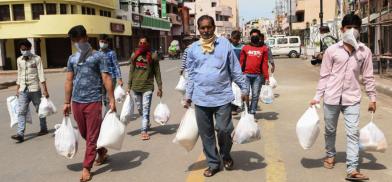Its Modi’s moment to transform rural India with reverse migration
This is Modi’s moment to transform India. He has the ability to not waste this opportunity to make the migrants stay in their safe homes and not allow them back to the cities., writes Rajendra Shende for South Asia Monitor

Prime Minister Narendra Modi is at his best in a crisis. He knows the pathways to transform the crisis into an opportunity. COVID-19 pandemic has compelled him literally to lock down the world’s largest democracy with advance warning of just about four hours. This triggered an unprecedented and unplanned reverse migration of 40 to 50 million, out of India’s 95 million internal migrants from cities to their villages. These migrants are traveling by bus, train, and even walking home from their temporary shelters in the cities. The highways in India have turned into footways. Such an exodus has never before been witnessed in India.
The last time India witnessed such a large-scale displacement was in 1947. At that time, people were compelled to relocate as the subcontinent was partitioned by the British into two independent nation-states - India and Pakistan. But at that time also, the displacement of population from both India and Pakistan was estimated to be smaller, said to be not more than 12 million. Even in the 1970s, during the war with East Pakistan (now Bangladesh), those displaced were estimated to be about 10 million.
Interestingly, but relevant to COVID19, such reverse migration of a different nature took place in China in the early days 2020 when the virus spread had just begun. China annually sees such a reverse migration during its Lunar New Year holidays when hundreds of millions of Chinese workers, much more than India’s migrant workers, travel from cities to their homes in villages - by trains and air - to celebrate with their families during the 40 days of vacation. During this time, the entire country literally closes down, including its factories and business. This year Chinese Lunar New Year holidays were from January 10 to February 18. This was the exact time when the coronavirus was raging, while China was still guessing about its possible consequences. In any case, no social distancing was possible during such a time when there is a massive rush, though Chinese authorities did advise the travelers to be cautious.
The World Health Organisation (WHO) later said that the Lunar New Year travel in China contributed to the faster spread of the virus. Hence, while India’s distressful reverse migration was the result of COVID-19, China’s festive reverse migration contributed to the cause of the virus. But that difference precisely provides the opportunity to Modi’s government to possibly make a difference.
The migration of India’s human capital from rural to urban hubs started after independence and gathered speed after economic reforms linked to globalisation in the 1990s. The exceptional acceleration was rallied further by the emergence of India as a global soft power soon after. Most of these migrants are unskilled and semi-skilled workers, who have left behind their homes in the villages, their agricultural land, and more importantly, their traditional knowledge, and this is what PM Modi talks often about when he highlights "respecting and worshipping the nature" . Only a small percent of these migrants are young professionals.
Today every minute about 30 people are migrating to Indian cities from rural areas in search of better livelihood and lifestyles. Lack of infrastructure similar to urban centers and outdated agricultural practices that degrade the land, water, and farm produce have brought nearly 450 million rural migrants to the cities. That figure in the next ten years would reach 600 million.
Many Keynesian economists term this migration as an unparalleled opportunity of massive enhancement of consumer demands. Obviously, those economists have still not learned the lessons of possible causes of COVID-19 and the benefits derived due to the lockdown to the environment. As a result, we will soon forget the lessons learned from the current pandemics - the way we did in the case of the Spanish flu, SARS and Middle East Respiratory Syndrome-related coronavirus(MERS-CoV) and Ebola. It is evident that economic cost is being calculated today, and the cost to the environment is not counted.
Finance Minister Nirmala Sitharaman on Thursday unveiled the second tranche of the government's Rs.20 lakh crore fiscal stimulus, focused exclusively on migrant workers, street vendors, and small farmers. This included extra ration, a universal ration card that would work across the country, and an affordable rental housing scheme. She agreed that “there is a national and legitimate concern about migrants returning to their home states” in desperation. But the key dilemma before the government was whether to allow them to take crowded trains and buses to reach their native villages or to provide them with food, shelter, and protection against COVID-19 by keeping them where they were.
Many of these migrants are now heading homes to be with their families and relatives. It would provide them with mental security. Now that the government has taken care of their ‘plate’ at least for immediate needs, there is an urgent need to help them to ‘plough’.
This is Modi’s moment to transform India. He has the ability to not waste this opportunity to make the migrants stay in their safe homes and not allow them back to the cities. Modi holds the dream of doubling the income of the farmers, greatly enhance the efficiency of Indian agriculture and improve the livelihood and lifestyle of the labourers.
Mahatma Gandhi had said that "India lives in its villages". He always wanted rural India to prosper through the small and cottage industry. Village level governance, akin to self-reliance has been Gandhi’s proposition. India’s former President A A P J Abdul Kalam had given a practical dimension to Gandhi’s dream. Kalam had said that young India can only cherish and realise his or her dreams in villages if the infrastructure there is as good as in urban hubs. Kalam had, therefore, proposed the social and economic transformation project called, PURA, which is Providing Urban Infrastructure in Rural Area.
Modi government’s Rs. 20 lakh crore package includes infrastructure as one of the five pillars of self-reliance (Atma Nirbhar). Focusing on upgrading rural infrastructure at par with urban hubs would strengthen that pillar. One of the other pillars proposed by Modi is technology. For example, there is now a very strong case for farmers to adopt technology and start harvesting solar energy along with food. In her maiden budget speech in 2019, Sitharaman had stated that ‘annadata’ (food provider i.e farmer) can also become ‘urjadata’ (energy provider).
Modi has also pledged to double farmers’ income by 2022. Farmers deploying solar panels in their arid land and government leasing the degraded land (instead of transfer of money) to farmers to install solar panels has a multitude of advantages, including moving away from fossil fuels, reducing air pollution, meeting pledges given in Paris Climate Agreement, growing better crops in the scattered shadows and even harvesting water for agriculture from the rain and dews falling on the panels.
This simple calculation shows that with 30 percent of degraded land India can easily provide enough solar energy to meet most of India’s needs. The vibrant demography (youth) and the demand (for energy) i.e. the other two pillars of Modi’s self-reliance theme, can then be further strengthened. As regards finance for such projects, India already has institutions nurtured by Modi, like the International Solar Alliance, Asia Infrastructure Investment Bank, World Bank, which has pledged the green finance for climate change, and even the Paris Climate Agreement’s financial mechanism under which India could use its global positioning and press for much-needed finances.
Solar energy is just an example. Moving the big industries like electric vehicles (EVs) manufacturing units, healthcare industries, IT industries to rural areas with urban infrastructure would provide the much-needed boost to the ‘India living in the villages’.
(The writer is Chairman TERRE Policy Centre and former Director, UNEP. The views expressed are personal. He can be contacted at shende.rajendra@gmail.com)










Post a Comment